Preparatory Notes for Chicago Comedy (2013)*
Goshka Macuga in collaboration with Dieter Roelstraete
English Abstract
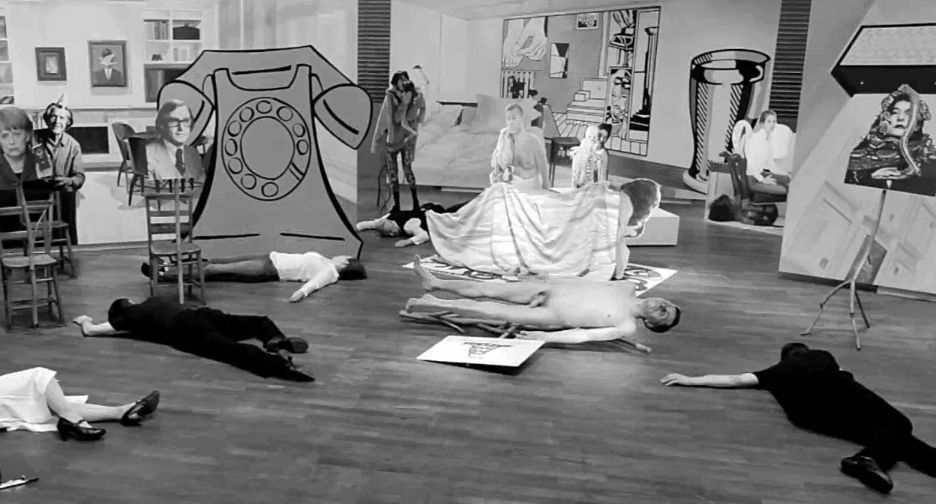
1 | The actors are lying down across the stage, dead, between the cutouts. Gestures from the Preface in the performance-film of Preparatory Notes for a Chicago Comedy (2013-2014). The performance-film was created with footage of the playlet as it was performed at the Staatliche Museen zu Berlin performance, Museum Dahlem, 8th Berlin Biennale 2014.
Cast:
Actor 1
Actor 2
Actor 3
Actor 4
Two Dancers
Guest appearances by the following cardboard cutout figures:
Marina Abramović [1]
Roman Abramovich [2]
Richard Artschwager [3]
Ludwig Binswanger [4]
John Cage [5]
Marcel Duchamp [6]
Andrea Fraser [7]
Goshka Macuga [8]
Angela Merkel [9]
Dieter Roelstraete [10]
Jan Van der Marck [11]
Aby Warburg [12]
Dasha Zhukova [13]
An unidentified Hopi man [14]
Dead Dad [15]
Set 1
A collector’s living room, outfitted with a giant telephone, chairs and cutouts of Marcel Duchamp, Angela Merkel, Jan Van der Marck, John Cage and Richard Artschwager.
Set 2
The hallway of a collector, with Sarah Morris’ Insane painting and cutouts of Hopi man, Aby Warburg, Marina Abramović and Dieter Roelstraete.
Set 3
A bedroom with Roy Lichtenstein painting, a bed, and cutouts of Marina Abramović, Roman Abramovich, Dasha Zhukova, Andrea Fraser, Dead Dad, Goshka Macuga and Dieter Roelstraete
Preface
Sets: the three backdrops, the giant telephone, the chairs and all the cutouts.
The actors are lying down across the stage, dead, between the cutouts. Aby Warburg 2 (Actor 2) makes the sound of a trumpet. Aby Warburg 1 (Actor 1) lies at the back of the stage, puts his glasses on, stands up, looks about and walks in and around the cutouts towards the audience. He is wearing a white shirt and black suit.
Aby Warburg
(Actor 1)
Warburg 1 addresses the public in a measured tone with a German Jewish accent. His gaze moves around the audience; he gestures with his hands and moves around, occasionally reading from his script.
Ladies and gentlemen, esteemed members of the public, beloved yet oh-so elusive audience—welcome to Preparatory Notes for a Chicago Comedy. This piece —this work of art if you will— is the result of the collaboration between an artist and a curator; it involves acting and dancing, moving and speaking, and could be said to be one third choreography, one third lecture, one third performance. It is a play, and meant to be playful at that: we are aiming for many different goals here, but the most ambitious of all, perhaps, is to be funny. To entertain—to both amuse and bemuse. Hence the title: “preparatory notes for a Chicago comedy”—not, it should be noted, a Chicago tragedy.
I should also add that our play is based, very loosely, on an existing piece of amateur literature titled “Hamburg Comedy”—or, more precisely, the “Hamburg Conversations on Art and Culture.” This original Hamburg Comedy was written in Hamburg, yes indeed, sometime towards the end of the 19th century—in 1896 to be more exact. It was written, originally, for a family gathering, to be staged in the summer home of a wealthy German-Jewish banking family. In fact, it was staged only once, on the occasion of that family’s new year’s celebrations—don’t ask me why they were celebrating New Year’s eve in their summer home, but there you have it. 1896, that’s one hundred and eighteen years ago—that’s how long the Hamburg Comedy has been lying dormant, until now, more or less, when it was revived to become the Chicago Comedy, named after the city in which it was partly hatched out. But that’s a whole other story [editor: see "Wanting to See Duse" in the present issue of Engramma, no. 130].
Anyway… In this play, we set out to explore the possibility of traveling in time as well as space—the real science fiction deal. We will go different places, and traverse different eras. We will also plunge the depths of the human mind and investigate different mental states, most notably the grey area between madness and sanity, between reason and unreason.
A comedy—yet the subject is undoubtedly, irrefutably serious. Seriously-serious. We—myself, the actors, the artist, the curator, many of you even—owe our livelihood to it, and here we are, appearing within the context of it. It’s how we met, it’s why we’re all here—the art world. The. Art. World.
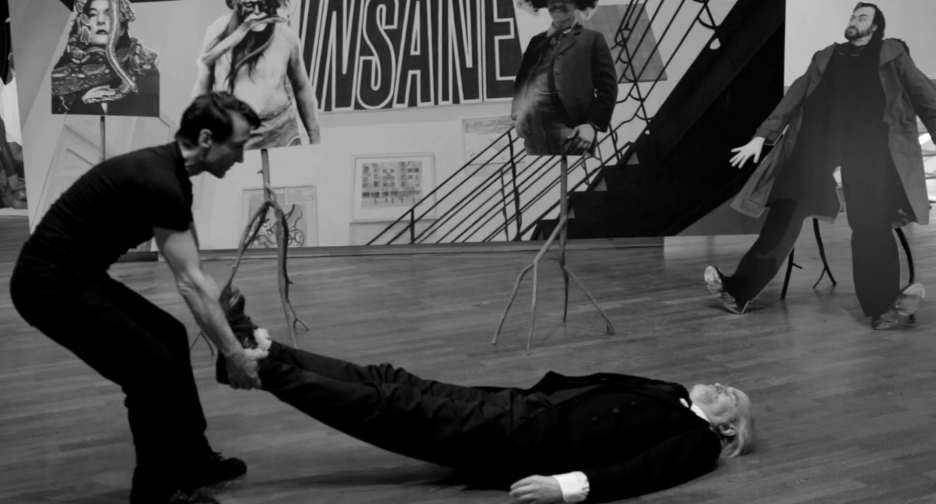
2 | The dancer drags [Warburg 2] a few metres towards the center of the stage: Gestures from the Preface in the performance-film of Preparatory Notes for a Chicago Comedy (2013-2014); footage from the Staatliche Museen zu Berlin performance, Berlin Biennale 2014.
While Warburg 1 continues to speak, a dancer dressed in black, stands up and walks to Actor 2 (Warburg 2), who is dressed in a white shirt and black suit. The dancer straightens his body and clothes out, drags him a few metres towards the centre of the stage, lifts him to a standing position and moves him next to Warburg 1. Warburg 2 looks bemused.
Which most of us, I believe, love and hate in equal measure. Love it and hate it, all at the same time, all the time. I love it; I hate it. Needless to say, we are not the first to rack our brains about this, nor will we be the last. My goodness, nein.
Which is why we, once again, enlisted the help of a trusted old comrade here, who likewise suffered from the depressive state brought on by] these exact concerns—Abraham, or Aby, as his family liked to call him, Warburg.
The dancer contemplates the Marina Abramović cutout, he then leaves the stage from the left
I am Aby Warburg.
Warburg 2 interjects. Warburg 1 and 2 argue and gesture angrily
I will be Aby Warburg.
I will be playing Aby Warburg—but I will also play many more characters besides. Indeed, sometimes it is useful ..
Warburg 1 takes Warburg 2 in hand, both are smiling
.. to suffer from schizophrenia—it allows me to slip in and out of different states of mind, different identities. Also, I can hear voices—and I will hear voices, all the time.
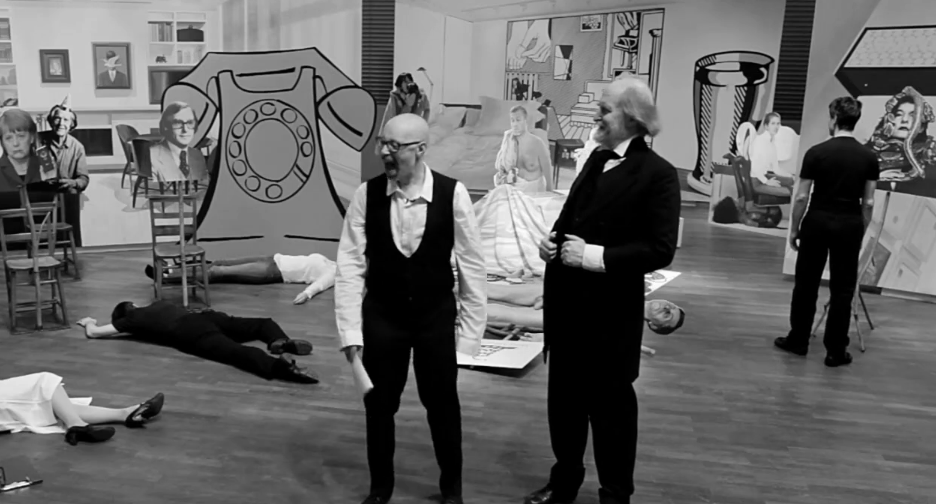
3 | Warburg 1 and Warburg 2 in the Preface of the performance-film Preparatory Notes for a Chicago Comedy (2013-2014); footage from the Staatliche Museen zu Berlin performance, Berlin Biennale 2014.
They both look up, Warburg 2 opens his mouth widely
Aby Warburg
Hello?
Warbug 1 and Warburg 2 both play around with saying "Hello?"
But let us start off with a little more background information about my humble, occasionally deluded self. My name is Aby Warburg;
A dancer comes over to Actor 3, (Dr. Binswanger) who is lying down. She is dressed in a white coat. The dancer drags, then lifts her and carries her across to the centre of the stage.
I was born in Hamburg in 1866. On June 13th, by the way—meaning he (I?) was a Gemini, just like the artist and the curator in fact. I was also born into serious wealth—born rich. Still, rich or not, I have many talents. I could have been an actor, for instance—if only I was a little bit taller. But you can’t have it all I guess. That’s Aby Warburg, of the Warburg institute, now housed in London—I went on to become a famous art historian.
Some of you may have heard of me, or have read some of the work I’ve done. My expertise concerned the early Renaissance (I lived in Florence for quite some time)—and some other things besides… Such as snake dances.
Warburg 1 and Warburg 2 dance, Binswanger is looking solemnly down at the ground. She carries a script under her arm.
Doctor Ludovica Binswanger
(Actor 3)
speaking in a serious, doctor’s voice
Let me intervene here—Doctor Ludovica Binswanger. Formerly Doctor Ludwig Binswanger, Warburg’s personal psychiatrist,
Warburg 1 is standing behind Warburg 2 who is holding onto the front of his coat
but I decided to have a sex change after artist and curator alike found that there are too many blokes running around the stage. There are always too many blokes running around the stage—as well as running the world.
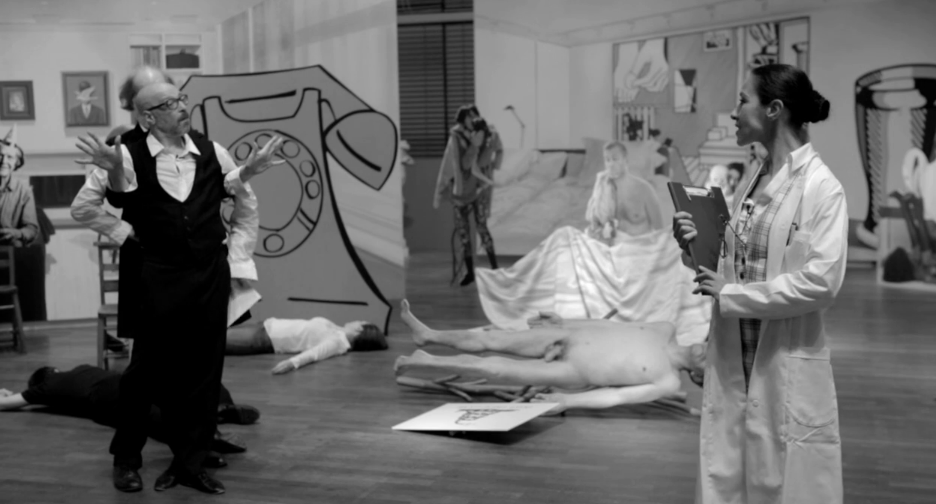
4 | Doctor Ludovica Binswanger in the Preface from the performance-film of Preparatory Notes for a Chicago Comedy (2013-2014); footage from the Staatliche Museen zu Berlin performance, Berlin Biennale 2014.
Binswanger smiles at the audience
It’s a recurring problem, you could say. Anyway, I’m here to proffer some objective clinical analysis.
Warburg 1 and Warburg 2 are walking around slowly, then come together; Warburg 2 is serious, then the two Warburgs start to lean on each other, playing around like kids, both look very pleased with themselves
For some reason, the art world simply loves Aby—they just cannot get enough of Aby. We can all see why of course—Aby is quite the looker. Just look at him! I guess it’s probably the heady brew of madness and academic unorthodoxy that he appears to embody so exemplarily. And the drama of course—he’s quite the drama queen, is Aby.
Aby Warburg
(Actor 2)
Queen?
(Actor 1)
Prince, rather. The scion of a Hamburg banking dynasty—yet I renounced my firstborn’s right to run the business. I never cared for banking. Instead of money I always only wanted knowledge and as many books as I could get my hands on. In fact that’s exactly what happened with my right to the family fortune:
A dancer comes on to the stage and lifts up the other dancer. Binswanger looks very serious, writing notes
I handed it over to my brother Felix, second in command, in return for his lifelong sponsorship of my reading habits. It’s a serious problem I have, this bibliophilia thing. Books, books, books!
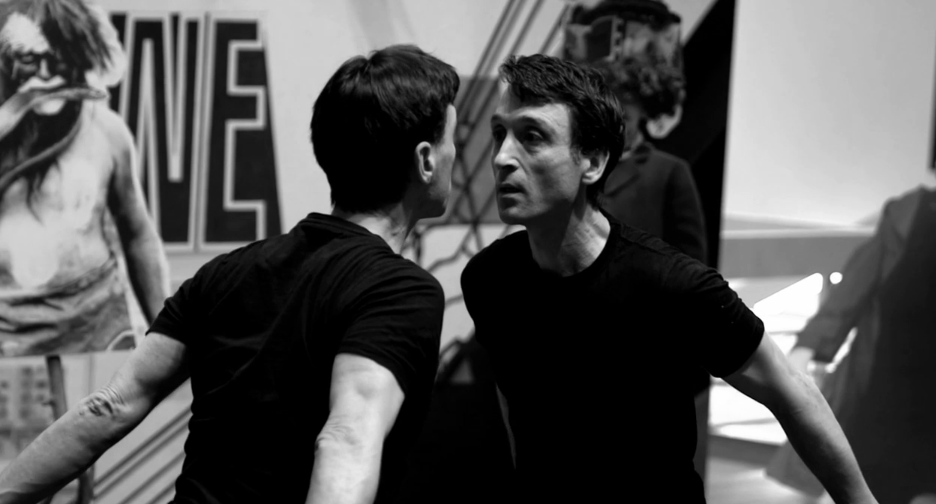
5 | [The two Warburgs] look over to the two dancers (twins) next to them who are doing a mysterious mirror dance: Gestures from the Preface to the performance-film of Preparatory Notes for a Chicago Comedy (2013-2014); footage from the Staatliche Museen zu Berlin performance, Berlin Biennale 2014.
The two Warburgs gesture wildly. They look over to the two dancers (twins) next to them who are doing a mysterious mirror dance
Anyway, the authors of this play, the artist and the curator, likewise claim to be interested in knowledge—I believe they share an interest in art as a form of knowledge, even, in art as a “platform for both the production and distribution of knowledge”, as they say—but I am not sure whether they are lying or telling the truth. I am not even sure whether the play is finished at all… That is to say, if it is a play—maybe it’s not, and maybe it’s just a proposal for a play. There are many things we are not sure about—many unknowns, some of them known, some of them unknown.
The two Warburgs are together at the front of the stage and the dancers stand over Binswanger reading her notes
For now our playlet consists of three scenes, but it may actually be expanded in the future, or be performed differently. All depending on the context or the time of the year or the mood they’re in, the mood we’re in. You know those artsy-fartsy types—they can never quite make up their minds.
The dancers lift up the actor playing Jan van der Marck and move them to the cutout solemnly
Always protected by the charm of doubt and the rhetoric of ambivalence—that’s how they seem to get away with everything.
The dancers leave the stage
Just call it “preparatory notes”! The cheek of it all! Well—we will see.
Binswanger leads both Warburgs offstage; Warburg 2’s arms in the air
Scene One: Aby Warburg on Technology
Set 1: ‘Art by Telephone.’ A collector’s living room
The chairs are already on the stage with the cutouts installed facing the audience. The actors playing the roles of Jan Van der Marck and John Cage are sitting on the chairs behind the cutouts. All of a sudden, a telephone starts to ring really loudly
Jan Van der Marck
(Actor 4)
Hello? Yes, speaking… Jan Van der Marck here, the MCA’s founding director… I am calling you with regards
The actor playing the role of Duchamp enters the stage and sits on the chair behind the cutout of Duchamp
to an exhibition I am curating based on a work by Laszlo Moholy-Nagy from 1922. The project is called “Art by Telephone”… Which I would like to invite you to be a part of… No, the year is not 1922, not quite… Yes, Moholy-Nagy. No, he’s dead.
The phone rings again

6| [Actor 3] reading from a letter with one hand in front of the [Marcel Duchamp] cutout as if he was on the phone: gesture from Scene One in the performance-film of Preparatory Notes for a Chicago Comedy (2013-2014); animation overlay on footage from the Staatliche Museen zu Berlin performance, Berlin Biennale 2014.
Marcel Duchamp
(Actor 3)
In a voice with a strong French accent, reading from a letter with one hand in front of the cutout as if he was on the phone
Hello dear Mr. Van der Marck, this is Marcel Duchamp speaking. I am in Cadaquès in Spain right now. It is July 11, 1967, meaning that Goshka Macuga is exactly twenty-six days old, and your Museum of Contemporary Art has yet to open. So, with regards to your letter sent sometime earlier this year… I find the idea of “art by telephone” quite brilliant but do not feel like participating, for different reasons, the most important one being my state of non-activity. I don’t feel strong enough to undertake any action, even “by telephone”. With my regrets, I hope you still understand and make a success of the show. Sincerely yours, Marcel Duchamp.
Silence. The phone starts ringing again.
The actor playing Richard Artschwager moves towards the chair and sits behind the cutout.
John Cage
(Actor 2)
Played by one of the dancers, in a neutral accent.
Hello! Uhm… Hi there, John Cage here. Though I am all for it, that is to say I’m all in favor of your exhibition project Art by Telephone, I have not thought of some way in which I could usefully participate. Most of what I do involves the telephone. I notice that by telephoning I do my work. That is to say, when I’m working well, my bills go up.
The actor stands up and leaves the room. The phone starts ringing again.
Richard Artschwager
(Actor 2)
Played by Actor 2 in a loud American accent.
Hello, this is Richard Artschwager speaking. Yes. I have just telephoned a friend and instructed him to steal an oriental rug
The rolled up carpet is brought to the stage by a dancer. He unrolls the carpet in front of the audience and starts to perform the carpet choreography.
and deliver it to the museum.
The museum wants me to label it “Stolen Oriental Rug.” That’s not okay. You don’t have stolen things labeled as such in a museum. It’s tripping people up.
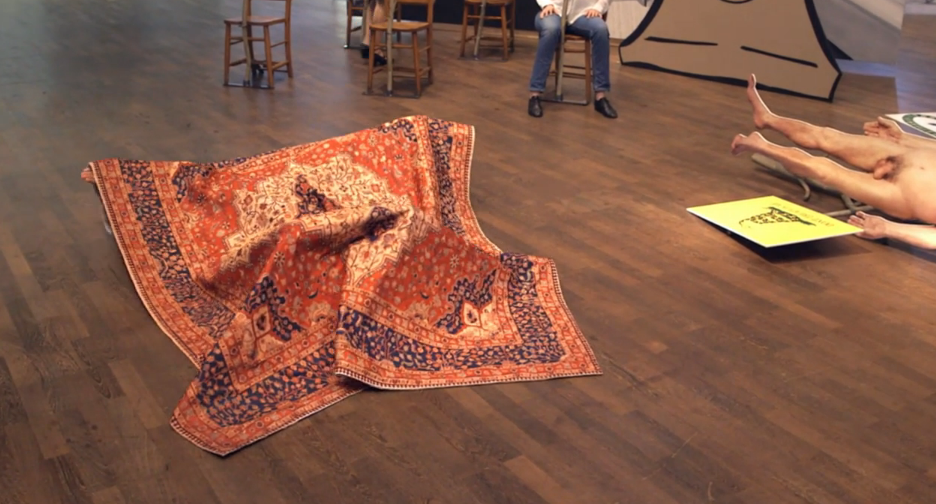
7 | The "carpet choreography" in Scene One from the performance-film of Preparatory Notes for a Chicago Comedy (2013-2014); footage from the Staatliche Museen zu Berlin performance, Berlin Biennale 2014.
Silence. The phone starts ringing again.
Aby Warburg
(Actor 1)
Walks towards the audience slowly while the carpet performance continues.
Hello there… Yes… It’s me, Aby.
The actor who is doing the carpet performance dives under the carpet.
Uhm, OK…
Warburg pulls out a piece of paper, straightens it out, clears his throat and starts reading rather theatrically.
“At a press preview of the exhibition “Art By Telephone” at the Museum of Contemporary Art, President Joseph Randall Shapiro remarked that one of the audacious objects on view is a work by Richard Artschwager of New York entitled “Stolen Oriental Rug.” Says Joe Shapiro: “Lest any of our friends harbour suspicions that we are receivers of stolen property, let me assure you that no theft is involved but that the artist is engaged in an innocent but serious game of absurdity and illusion. This is in the tradition of the great Marcel. The Dadaists and Surrealists have always pushed the limits of truth and logic. Mr. Artschwager works within that tradition.”
Folds up the paper and walks towards the large cutout of the telephone and hides behind it.
Jan Van der Marck
(Actor 4)
Played by Actor 4 with a British accent.
And so “Art by Telephone” demonstrates how ordinary materials and objects may be turned into art by the artist’s fiat. No works in this exhibition have failed to live up to that essential expectation.
Silence. The phone starts ringing again.
Insurance Salesman
(Actor 1)
From behind the cutout of the large telephone in a cockney accent:
Hello… Oh, hi there! My name is Jason and I’m calling from “No Win, No Fee” accident insurance. Have you had an accident in the last 6 months? The reason for my call is this. We just made your studio neighbour John Cage $12 million in an unprecedented claim. He poured 200 gallons of orange juice into his left ear and hasn’t been able to hear anything since. I thought it was important to let you know, and to ascertain if we could do a similar thing for yourself.
Ring, ring.
Marcel Duchamp:
(Actor 3)
Hello?? I peed my panties and missed the urinal. How much can I get for that ready-made?
Ring, ring.
Jan Van der Marck:
(Actor 2)
Hello? Yes… Yes, if you ever call me again rest assured it will be the last call you ever make.
Ring, ring.
Mister Bradshaw
(Actor 1)
Walks out from behind the telephone cutout. Speaks in an American accent:
Hello... Is this Mister Joseph Shapiro? Yes… Well, I was absolutely flabbergasted when I found that Richard Artschwager has received your approval to exhibit stolen property.
The dancer and the actor who will perform Angela Merkel walk towards the chairs and the dancer picks up the cutout of Angela Merkel.
I do not care what Mr. Artschwager’s thinking is as to how this portion of this show is to be presented, but I do care a great deal that my name and effort not be involved with any organisation which is so foolish as to place itself in such a perilous position.
Silence. The phone starts ringing again. The Angela Merkel cutout is brought onto the stage by the dancer and the actor walks behind the cutout speaking. The second dancer with the carpet puts the carpet on his head and styles it to create the look of the Holy Mary and hops towards Angela Merkel.
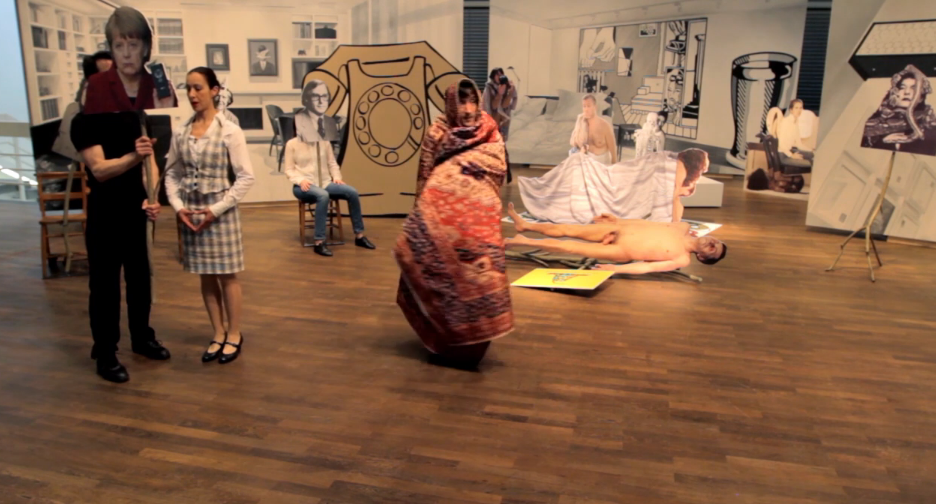
8 | The Angela Merkel cutout is brought onto the stage (...) and the actor walks behind the cutout speaking: gestures from Scene One in the performance-film of Preparatory Notes for a Chicago Comedy (2013-2014); footage from the Staatliche Museen zu Berlin performance, Berlin Biennale 2014.
Angela Merkel
(Actor 3)
Speaking in a German accent:
Hello? Barry? Barry, are you there? Is that you, Barry? Barack? Mr. Obama?? It’s Angie. Well, Angela Merkel. OK, Frau Merkel. Listen, about this phone-tapping business… Honestly—
The cutout of Angela Merkel is taken back to its chair by the dancer. The actor leaves the stage and the second dancer with the carpet on his head also leaves the stage.
Warburg enters and addresses the audience.
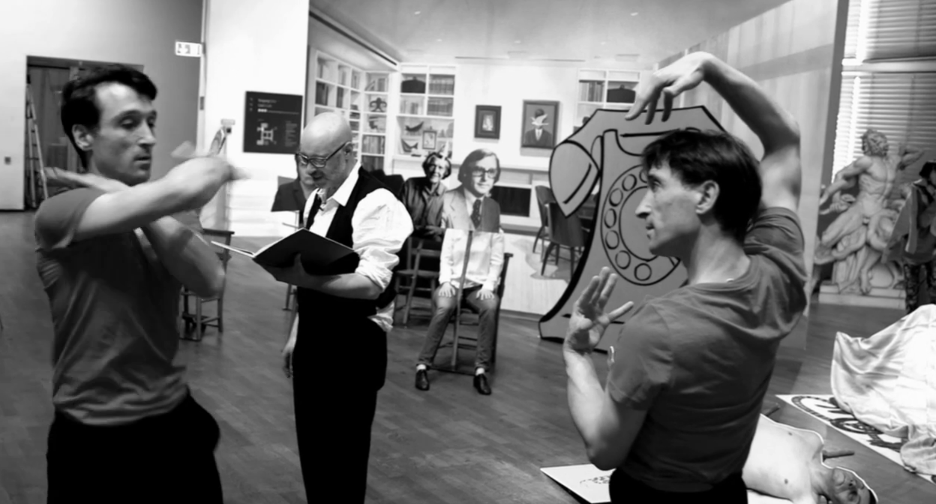
9 | Two dancers enter the stage and start voguing while Warburg quotes his own text: gestures from Scene One in the performance-film of Preparatory Notes for a Chicago Comedy (2013-2014); footage from the Staatliche Museen zu Berlin performance, Berlin Biennale 2014.
Aby Warburg
(Actor 1)
Art by Telephone—brilliant idea. For 1967, that is. Not so sure how it would work today though. I mean, first of all, it would probably be Art by Skype. Or Art by Email. All art is conducted by telephone these days, by the airwaves, by satellite. Or by undersea cables… Secondly, with all the snooping and spooking and spying going on… Looking up, at the sky] And all those drones flying around… Artists have unwittingly become enablers of worldwide surveillance!
Two dancers enter the stage and start voguing while Warburg quotes his own text.
As a matter of fact, all of this was somehow presaged—of course it was—in a lecture I gave as far back as April 1923, about the serpent ritual of the Hopi Indians of Arizona in Doctor Ludovica Binswanger’s sanatorium, I should say—but I’ll come back to that in the next scene. Allow me to quote at some length from my own lecture then, dear patient audience:
Pulls out a piece of paper and starts to read, affectedly
“The American of today no longer worships the rattlesnake. Extermination (and whisky) is his answer to it. Electricity enslaved, the lightning held captive in the wire, has produced a civilization which has no use for heathen poetry. But what does it put in its place? The forces of nature are no longer seen in anthropomorphic shapes; they are conceived as an endless succession of waves, obedient to the touch of a man’s hand. With these waves the civilization of the mechanical age is destroying what natural science, itself emerging out of myth, had won with such vast effort the sanctuary of devotion, the remoteness needed for contemplation. The modern Prometheus and the modern Icarus, Franklin and the Wright Brothers who invented the airplane, are those fateful destroyers of our sense of distance who threaten to lead the world back into chaos. Telegraph and telephone are destroying the cosmos. But myths and symbols, in attempting to establish spiritual bonds between man and the outside world, create space for devotion and scope for reason which are destroyed by the instantaneous electrical contact unless a disciplined humanity reintroduce the impediment of conscience.”
Jan Van der Marck
(Actor 4)
Well-said, mister Warburg! Since the invention of the telephone, however, we have gone on to create another global network—that of the Internet. This may not have exactly destroyed the cosmos, but it has provided us with another space that allows us to communicate with the whole world and beyond. It also gives us space for contemplation—the auratic space of the computer screen we devoutly contemplate for hours and hours on end each day of our lives.
Aby Warburg
(Actor 1)
Looking towards Van der Marck
I disagree. It’s that very screen, my dear sir, which is distancing you from man’s true spiritual bonds with nature. In no way does it connect you to the outside world like it pretends to—it only gives the illusion of doing so. The worldwide web—it was supposed to be a democratic platform free from political control, and instead it has become a space in which your every idea, your every emotion and your every interaction is turned into a commodity.
Dieter Roelstraete
(Actor 2)
Warburg 2 walks towards Dieter Roelstraete
Alright Mr. Van der Marck and Mr. Warburg. These are both good points, and well made on top of that. But let us return to the matter of Art, shall we? Where is Art in all of this? Surely there is a contradiction in terms here… If technology is used to solve problems, achieve goals and give answers, doesn’t art do the exact opposite? Indeed, artists may use technology but most often they use it to create more problems and instead of solving them and giving answers they just ask more questions. Art and technology just don’t mix well. That said however, how on earth would we ever have produced this play without Skype or telephone or the worldwide interwebs net? I mean, sending a little pigeon across the pond with all our little preparatory notes strapped to its little feet would have taken much too long, wouldn’t it? Not that that would necessarily have been a bad thing though… Why does everything have to be rushed anyway? Why does everyone always want everything right now, this very minute, subito presto?
Van der Marck leaves the stage. Warburg 2 walks towards Goshka Macuga cutout
Goshka Macuga
(Actor 3)
I actually side with Aby here—all of this technology business is killing the spirit of art. As well as the spirit proper—that is to say, my spirit. I hate my phone—but I love my bison grass vodka. And I hate many more machines besides my phone. I mean, why does every living second of our life have to be recorded and registered? Why does everything have to be filmed and photographed and stored away for some delusional posterity or other? It’s driving me mad. Like, why do I have to explain what I do in front of a camera, for crying out loud? Imagine prehistoric man, or rather, prehistoric woman, sitting in her cave, stroking her Neanderthal mons and having to explain her cave paintings to a gawking film crew…
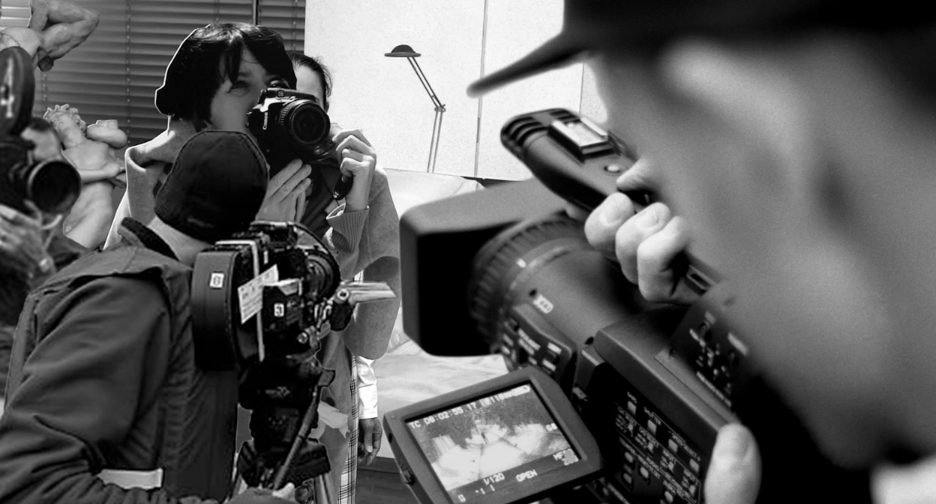
10 | The Goshka Macuga cutout surrounded by animation overlay of a gawking film crew in Scene One from the performance-film of Preparatory Notes for a Chicago Comedy (2013-2014); animation overlay on footage from the Staatliche Museen zu Berlin performance, Berlin Biennale 2014.
Aby Warburg
(Actor 1)
walks towards the audience
What all this amounts to really, what I was meaning to say all along, is that there no longer exists any space for contemplation. There is no reprieve and no respite. Search engines run our world! Youtubes and facebooks! Twitters, you tweeting twits! The tyranny of immediacy!
Warburg 2 walks and stands next to Warburg 1
Total visibility and total availability, all the bloody time! Honestly, I much prefer the slow, staid world of myth. Give me myth any time.
Warburg 2 starts screaming in terror
Scene Two: Aby Warburg on Madness and Ritual
Set 2: living room, outfitted with a giant telephone
The two Warburgs enter the stage. Warburg 1 goes to sit within the audience, reading from a clipboard. Warburg 2, in a state of madness and paranoia, screams at the top of his voice, turning around repeatedly
Aby Warburg
(Actor 2 playing Warburg 1)
OK, this is the crazy part. As is well enough known, I lost my marbles for a bit there.
Warburg 2 moves jerkily and shaking, scratching his head and falling to the floor
I had always been quite excitable and a nervous type, but finally experienced a major collapse in the fall of 1918—just in time to coincide with the collapse of the German Empire, in fact.
Warburg 2 shouts, continuing to shake
Deutschland über Alles!
(Actor 2 playing Warburg 1)
Deutschland Unter Anderen.
Dr. Binswanger enters with white coat, glasses and clipboard from the left side. Warburg 2 stands up slowly
For a little while I was shipped from one nursing home to another until I came under the care of Doctor Ludwig Binswanger of Kreuzlingen, where she ran a sanatorium un-ironically named
Both Warburgs together]
“Bellevue.”
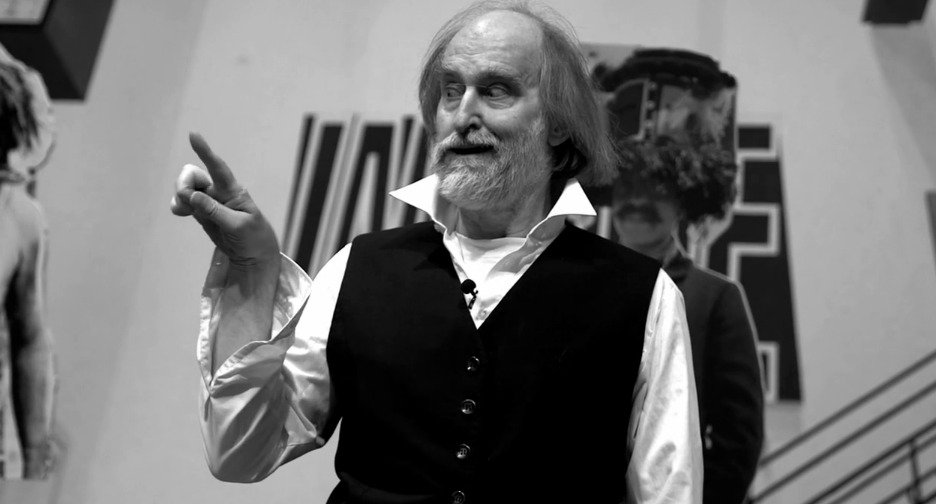
11 | Warburg 2 holds up his first finger; he does a snake like dance : gesture from Scene Two in the performance-film of Preparatory Notes for a Chicago Comedy (2013-2014); footage from the Staatliche Museen zu Berlin performance, Berlin Biennale 2014.
(Actor 2 playing Warburg 1)
That’s somewhere in Switzerland.
Warburg 2 approaches Warburg 1, knocking him from his chair and making him fall. Then in the centre of the stage he holds the chair in front of him, following it back and forth and in a circle, nervously and with speed, as though the chair were in charge of him
For a couple of years my situation looked positively hopeless—until 1923, that is, when I started to recover.
Warburg 2 now puts the chair down calmly and strokes it
And to prove to my doctors that I was ready for the real world again, and that I had regained my mental stability, I proposed to give a lecture to my fellow patients
Warburg 2 holds up his first finger, he does a snake-like dance
about the Hopi snake ritual I had heard about so many years ago. (I never really saw it myself.) Well, I can be more precise than that—the snake ritual I had heard about in 1896,
Warburg 2 is biting his arm as if it is a snake, then moving his hips and arms
which is when I traveled to America for the first and only time in my life. And you will probably remember that 1896 is also the year I wrote the so-called Hamburg Comedy upon which this play is partly based. But how partly? Okay, granted, very partly, only very partly. Anyway my lecture on the serpent ritual… My interest in serpentine imagery across cultures and through the ages… It is a well-established trope, I would say.
Warburg 2, with arms outstretched
Beginning with Adam and Eve—
(Actor 2 playing Warburg 1)
moving on to the Laocoön group—appearing in many primitive societies around the world, such as the various
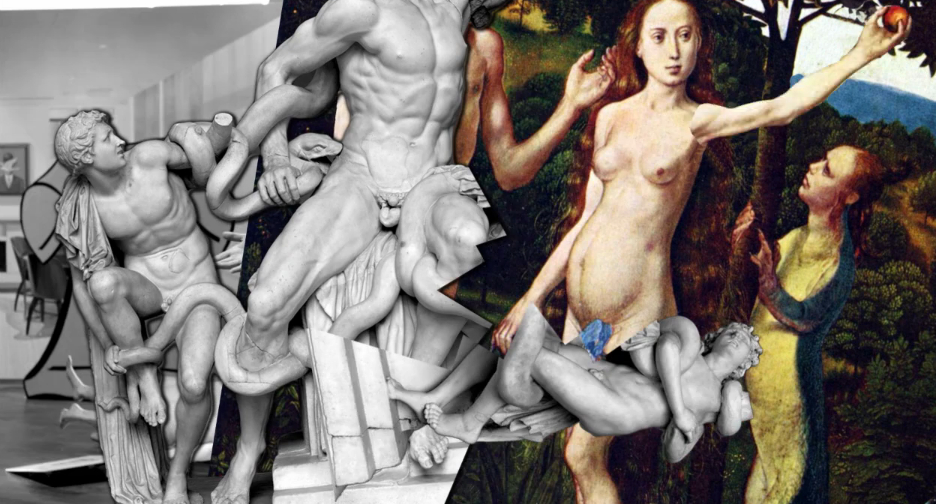
12 | Animation overlay with images of the Laocoön group (circa 1st century AD) and Hugo van der Goes' The Fall from the Vienna Diptych (c. 1470) from Scene Two in the performance-film of Preparatory Notes for a Chicago Comedy (2013-2014); animation overlay on footage from the Staatliche Museen zu Berlin performance, Berlin Biennale 2014.
Warburg 2 in German
Pueblo tribes of the American Southwest—
Warburg 1 (Actor 1) now turns into the Hopi Man, standing behind the cut out
Hopi Man
(Actor 1)
Loudly and forcefully
Excuse me, but who are you calling primitive here? What do you think I am anyway, just some fucking tourist attraction?
Aby Warburg
(Actor 2)
Rubbing his hands together nervously
Apologies, my dear fellow. I did not mean to insult you or anything…
Hopi Man
(Actor 1)
I know that we’re in a museum of ethnology here, which makes a lot of things look like the work of illiterate savages but still… Indeed, why can’t the art of us so-called ‘others’ ever be shown as art, in an art museum? And if is accepted or regarded as art at all, why only as “outsider” art? Aren’t we all inside the same world of art? Ugh—don’t get me started. I could drone on forever about this…
2 dancers with identical head to toe snake costumes enter one by one from the right hand side, slithering forwards on the floor
Anyway, about the serpent dance—
Marina Abramović enters stage left. She is wearing a checked suit and white shirt. She clasps her hands strictly in front of her
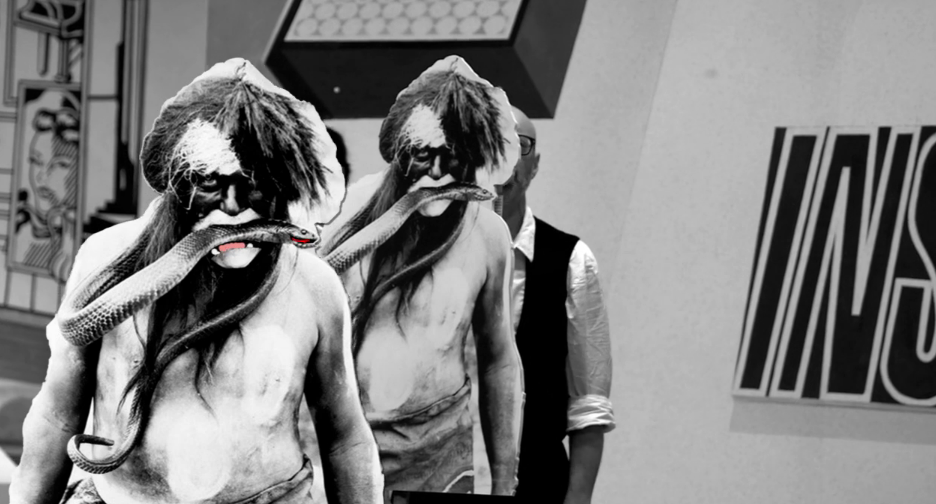
13 | Warburg 1 (Actor 1) now turns into the Hopi Man, standing behind the cut out: gesture from Scene Two in the performance-film of Preparatory Notes for a Chicago Comedy (2013-2014); footage from the Staatliche Museen zu Berlin performance, Berlin Biennale 2014.
Marina Abramović
(Actor 3)
In an exaggerated Eastern European accent
Snakes can follow the energy of the planet wherever you put them.
Aby Warburg
(Actor 2)
Marina! I was waiting for you to pipe in. We were all waiting for you to pipe in… Now if I remember correctly, you actually have performed a snake-dance-cum-serpent-ritual of your own, have you not?
The snake dancers are slowly moving to a standing position
Marina Abramović
(Actor 3)
You must be thinking of this performance Ulay and I did back in Wiesbaden in 1978 called Three…
Abramović holds one hand up with three fingers
There was a snake indeed—
Warburg 2 stands right behind Warburg 1 on the right of the stage, both listening intensely
the two of us plus Snake made three.
The two Warburgs hold up three fingers each. Abramović moves towards the ground at the front of the stage, lying down on her front, with hands pressing into the ground and chest and head raised. The dancers are lying on the left hand side of the, they slither towards Abramović until one is lying on top of her, the other kneeling behind, twisting their upper bodies from side to side
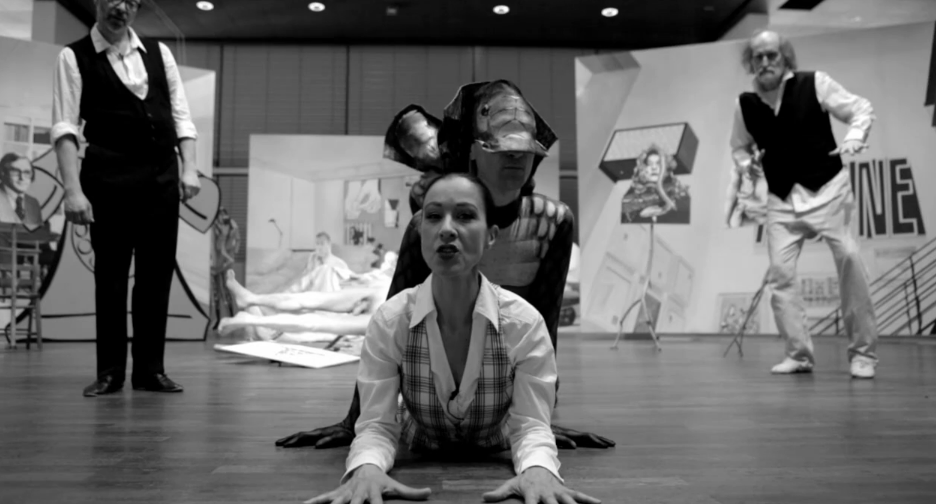
14 | Abramović moves towards the ground at the front of the stage, lying down on her front, with hands pressing into the ground and chest and head raised: gestures from Scene Two in the performance-film of Preparatory Notes for a Chicago Comedy (2013-2014); footage from the Staatliche Museen zu Berlin performance, Berlin Biennale 2014.
We were lying flat on our stomachs in one room together with Snake. We tried to make contact with Snake via an inventive system of sorts. We used a closed circuit made of wire, and blowing into a bottle or plucking the wire with our fingers,
The snakes now roll away from Marina and start to dance rolling on ground, sometimes legs raised. Both Warburgs are watching the snakes. Warburg 2 is doing a soft serpentine dance
we caused certain vibrations to be directed towards Snake. This would coax Snake to make a choice between the sides from which it received the vibrations—mine or Ulay’s. Was it any surprise that Snake was obviously much more interested in me than in Ulay? I don’t think so. So I would end up lying flat in front of Snake, kind of communicating with it by mirroring its movements.
Abramović is now moving in a snake-like way
Aby Warburg
(Actor 2 playing Warburg 1)
You do know that when a snake straightens itself out while lying next to you, it is actually measuring you, right? To see whether you’d fit inside? To see whether it can eat you?
Abramović and then the snake dancers all slowly stand up
Marina Abramović
(Actor 3)
Oh. I didn’t know that. The snake has often been construed to symbolize evil.
The snake dancers go to the ground again, going between writhing, and rolling up into yogic back bends. Marina is standing with Warburg 1 and 2
Yet it originally represented something much more positive—it symbolised the creation of the universe, no?
So that’s what I was trying to do in this performance Three: getting rid of the fear of snakes. But can I add something about performance art here? I know, I’m veering off topic here… It’s just that I’m not sure whether this is a performance piece
Warburg 1 and 2 come together once nervous then quizzical
that I’ve been dragged into or not. I mean, this Macuga woman, is she performance artist? This Roelstraete guy, performance expert? It’s all very fine, this Hamburg Comedy business but performance art has to live and survive. It cannot be put on walls. If we do not perform and recreate it, the art fuckers and the theatre fuckers and
Warburg 1 and 2 bow to Abramović
the dance fuckers will rip us off without credit even more than they do anyway. I am sick and tired of the mistreatment of performance art. Even the pop-video fuckers steal from it.
Warburg 1 goes to stand behind the Hopi Indian cutout. Marina slowly leaves the stage via the right
Hopi Indian
(Actor 1)
Art fuckers—that’s a good one. I’m in agreement with you there young lady! Though one thing I should point out seems absent from your reasoning is that the snake also symbolises forbidden pleasure—Adam and Eve and the snake in the Garden of Eden, remember?
Snakes dance on knees and ground
And all this talk of a snake straightening itself out while lying next to you… Sounds awfully phallic, doesn’t it?
Abramović returns from left to centre of stage
Marina Abramović
(Actor 3)
In my Balkan culture since ancient times male and female organs like phalluses, vagina, and breasts have been used as tools to ward off the evils of sickness and bad nature.
Aby Warburg
(Actor 2)
What? What? Am I hearing voices? I think I am. I might be hearing voices.
Warburg 1 and 2 shouting and covering their ears to avoid listening to Abramović
Marina Abramović
(Actor 3)
Just one more thing: in Balkan if the woman likes her lover or her husband, to make him love her in turn she will take a small fish and insert it in vagina
Abramović mimics these with hands
and leave it there overnight.
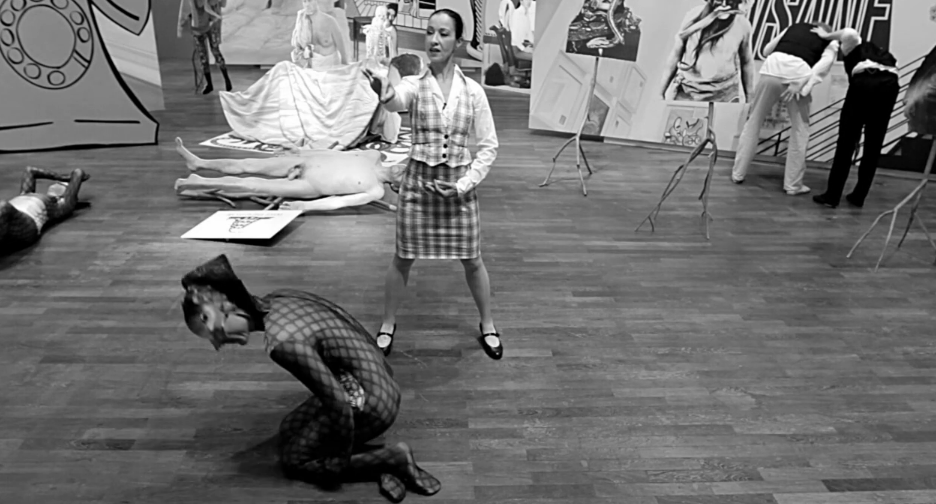
15 | “(...) to make him love her in turn she will take a small fish and insert it in vagina (...)”: actor playing Ludovica Binswanger, playing artist Marina Abramović, in Scene Two in the performance-film of Preparatory Notes for a Chicago Comedy (2013-2014); footage from the Staatliche Museen zu Berlin performance, Berlin Biennale 2014.
A snake lies between her legs, then comes up to a sitting position
If the fish die in the morning she will take fish out, then she will make a powder of it and mix it with coffee
Abramović is performing this with her fingers, the Warburgs are bent over throwing up next to ‘Insane’ on the right hand backdrop; the snakes repelled, slither away from her
and give to husband or her lover in the morning. It is believed that if he drink this coffee he will never leave her.
The two Warburgs come to standing. Warburg 2 is in shock, Warburg 1 comes to the front of the stage
Aby Warburg
(Actor 2 playin Warburg 1)
Okay. Gotcha. So, in 1921 I’m really in the depths of it
Warburg 2 on the right hand side of stage, trembles and comes to all fours on the ground facing up, moving back and forth like a crab, shaking, tapping his feet
—stark raving mad. It’s not looking good.
In fact it’s looking so bad that Doctor Binswanger feels called upon to write a letter outlining my condition to none other than Sigmund Freud—I have no idea whether Freud has actually ever heard of me, but I assume that somehow he must have. I certainly do not think very highly of Sigmund Freud.
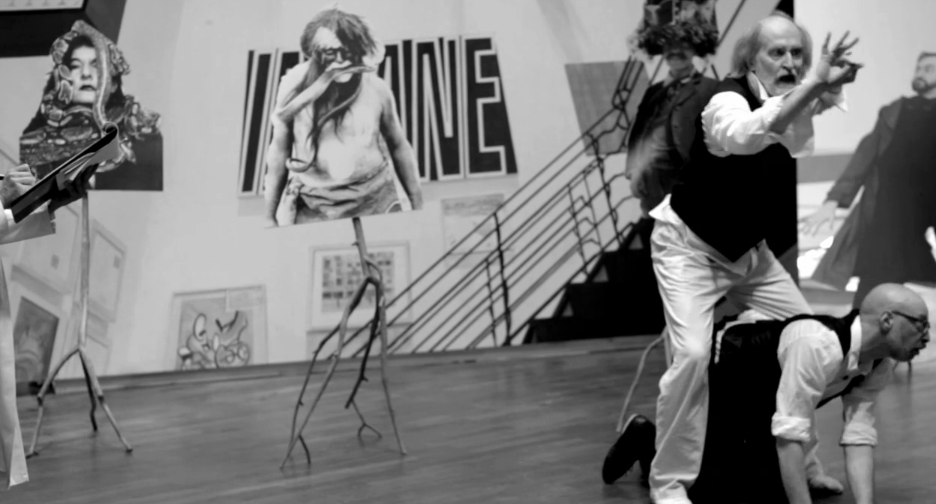
16 | Warburg 1 and Warburg 2 in front of Sarah Morris' Insane painting in the backdrop of a Chicago collector's living room. From Scene Two in the performance-film of Preparatory Notes for a Chicago Comedy (2013-2014); footage from the Staatliche Museen zu Berlin performance, Berlin Biennale 2014.
Warburg 2 stands up, puts his arms behind his back and then stretches in front of ‘Insane’ on the right hand backdrop
But that is not the point here. Let us listen to Doctor Binswanger instead.
Binswanger enters with hands in front of her standing behind Marina Abramović cutout
Marina Abramović
(Actor 3)
In Balkan to make the crops grow the man will masturbate onto the earth.
Binswanger moves in front of the Abramović cutout and speaks to her
Doctor Ludovica Binswanger
(Actor 3)
Thank you Marina, that’s quite enough for now.
Binswanger points to her watch
Your appointment is at 4 o’clock in room H.
Binswanger walks behind the ‘Insane’ backdrop. Both Warburgs are trembling. She returns from the left, stands in the centre, Warburg 2 joins her. She gestures with her pen for his back to bend; she rests her clipboard on his back. Clearing her throat, reading from a letter:]
Dear Professor Freud… Already in his childhood Warburg displayed various signs of anxious and obsessive behavior.
Warburg 2 mad, standing and moving up and down
As a student he was tormented by truly delirious ideas and never quite managed to overcome his fears and obsessive rituals, and this has inhibited his literary work. He is currently being held in the isolation ward. He remains interested in everything and absorbed in the analysis and judgment of both things and people.
Warburg 1 crawls through Warburg 2 legs from behind and stands up in front of him. Warburg 2 is writing frenetically in the air
His memory is excellent, but he can only focus on his scientific studies for a very limited period of time. I do believe that his psychomotoric excitement will weaken, but I don’t think that he will be able to
The two Warburgs are back-to-back and moving in circles, as if in a psychotic state
come out of the status quo ante of his psychosis; neither do I believe that he will be able to return to his scientific studies. Please treat this information with the utmost confidence.
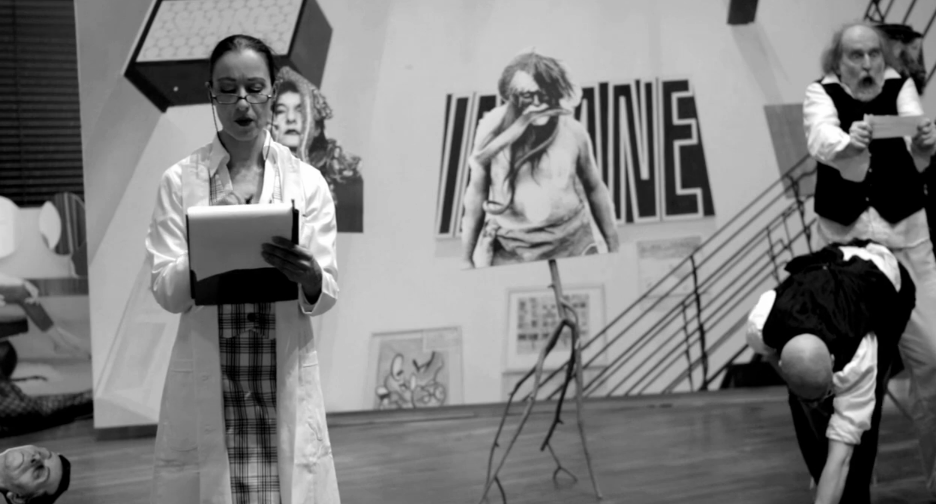
17 | The character Doctor Ludovica Binswanger reading psychiatrist Ludwig Binswanger's letter about Warburg to Sigmund Freud. From Scene Two in the performance-film of Preparatory Notes for a Chicago Comedy (2013-2014); footage from the Staatliche Museen zu Berlin performance, Berlin Biennale 2014.
Warburg 1 bends forward; Warburg 2 is standing
I feel very sad that he will no longer continue to mine the treasure chest of his considerable knowledge or his great library.
Warburg 2 is looking at the letter in horror
Sincerely, Doctor Binswanger.
Binswanger leaves to the left
Aby Warburg
(Actor 1)
wiser words were rarely spoken—
Warburg 1 has taken the letter, both Warburgs bent forward
though little did the good doctor know that I was eventually going to wake up from the sleep of unreason. Only to slump back into it towards the end of my life. I eventually passed away in the peaceful setting of my own home, if you are interested to know—not in the loony bin—just two days before the whole world came to a screeching halt
A snake dancer is crawling on the floor. Warburg 1 is still bent forward, Warburg 2 is holding his collar in horror
because of the first great Wall Street crash.
Warburg 2 smiling
But that is another story, one told in the next chapter.
Warburg 1 stands up, Warburg 2 takes him by the arm and Warburg 1 moves behind the Hopi cutout. Warburg 2 moves behind the Warburg cutout
Hopi Indian
(Actor 1)
Yeah, why don’t you tell us some more about rites and rituals for now—you seem to be quite the expert. After all, I’m not sure whether I’d call you an expert of serpentine ceremonial—
surely you know that your Laocoön and the Hopi snake dance don’t have anything to do with each other. Nothing at all. You really made that one up.
Warburg 1 and 2 move towards the cutouts; Warburg 1, standing in front of the Hopi cutout, is shouting at 2, standing by the Warburg cutout
You crazy German. Crazy Hamburger. Crazy art historian. Crazy Jew. Crazy heir to a banking fortune. Meshuggah. Nutjob. Crazypants.
Binswanger enters with clipboard. One snake is standing and rolls behind the set on the right hand side, the other rolls on ground towards audience
Doctor Ludovica Binswanger
(Actor 3)
Addressing first Hopi and Warburg, who have disappeared behind the cutouts, and then the audience
Allow me to intervene and proffer some clinical analysis here. Is the art world in love with Aby Warburg because the art world is in love with madness? Is the art world the only part of the world in which madness is somehow allowed—sexy even? Indeed, it seems that it is only OK to eat human fetuses if you can call it art. Otherwise, not so much.
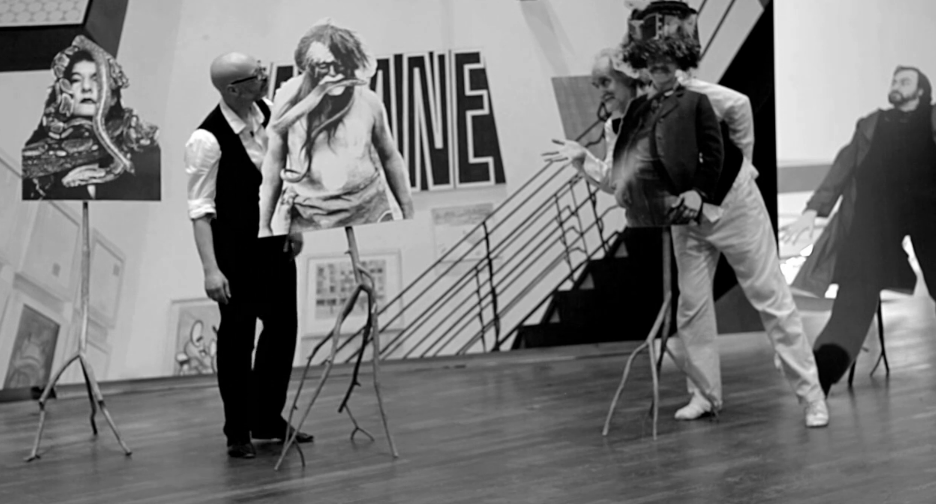
18 | Warburg 1 and Warburg 2 behind the cutouts of Hopi Indian and Aby Warburg. From Scene Two in the performance-film of Preparatory Notes for a Chicago Comedy (2013-2014); footage from the Staatliche Museen zu Berlin performance, Berlin Biennale 2014.
Marina Abramović
(Actor 3)
In Balkan…
Doctor Ludovica Binswanger
(Actor 3)
Occasionally looking down at her notes, then back to the audience
That’s enough Marina. In fact, it’s not just the art world that’s in love with madness—the whole world is. You could say that art is the one kind of madness
Binswanger taps her pen with force several times on her notes
the world desperately desires.
Hopi Man
(Actor 1)
Shouting and pointing his finger angrily
Yeah yeah, yada yad—deep shit. Warburg, you psycho! Looney! How about you tell us who brought you to the Hopi’s native lands anyway? A thieving missionary! Because that’s exactly how all those ethnological museums around the world got filled with our stuff—it’s basically all just loot. Aargh!
Walking towards the audience
If I ever get an Oscar for this role I’ll do much more than just follow Marlon Brando’s example and refuse it as a protest against the white man’s ongoing robbery of everything that is sacred to us! Shit, I shouldn’t be here anyway—I mean, in this museum. I should never have set foot inside any museum. But I guess I’m getting carried away again.
Coming to Warburg 2 who places his hand on his shoulder comfortingly
I should calm down and let you speak a little about ritual for a change.
Aby Warburg
(Actor 2)
Well, I believe this is a good enough example of one.
Hopi Indian
(Actor 1)
What, this play?
Aby Warburg
(Actor 2)
well, not exactly. I mean this gathering.
Both Warburgs move to the centre of stage
Warburg 2 stands behind 1, gesturing
These people gathering—for art.
Warburg 1]
Today’s pagan faith. I’m not going to go into the tiresome business of comparing museums to cathedrals, but still… This flying around the world to go see biennials and art fairs and all that—it really is like a pilgrimage, isn’t it? Or maybe not—maybe it’s more along the likes of the old westward expansion of the American Empire,
Warburg 2 is riding an imaginary horse and waving an imaginary lasso in the air
propelled by the revolution in railway building…
Maybe that’s what the globalisation of the art world, the proliferation of art fairs and biennials around the world, of manifestas and documentas and monumentas, is all about—following in the footsteps of the economic subjugation of the frontier.
Warburg 1 reads from a script, Warburg 2 stands behind him and exaggerates his gestures
I shudder to think of the first biennial soon to be organized on native Navajo land. Not that we want to idealise or romanticise the other, but it is worth asking whether the art world isn’t just the benign face of continuing colonialism… All these art events may appear innocent and naive and high-minded and idealistic but underneath they just serve to peddle the same authoritarian story of economic exploitation.
Warburg 1’s voice raises, and his gestures become more forceful
Underneath art’s best of intentions, it is all just business as usual…
Warburg 1 and 2, in unison, nod, then toss their heads back and exit the stage with speed
Scene Three: Aby Warburg on Art, Money & Politics
Set 3: bedroom
Warburg 1 enters the stage and stands at the back of the bed
Aby Warburg
(Actor 1)
This one is going to be difficult.
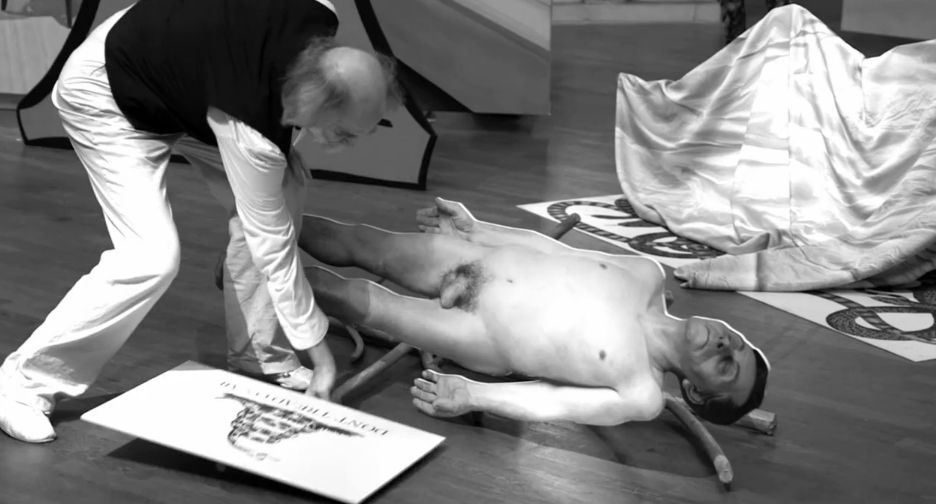
19 | Warburg 2 takes the Tea Party sign from Dead Dad: gesture from Scene Three in the performance-film of Preparatory Notes for a Chicago Comedy (2013-2014); footage from the Staatliche Museen zu Berlin performance, Berlin Biennale 2014.
Warburg 2 enters and takes the Tea Party sign from Dead Dad and carrying it over his shoulder, doing a funny walk off the stage. The dancers enter and move the dead Dad cutout to the right hand side of the stage
Or over easy, depending on how you look at it.
Actors 3 and 4 come from the left and sit on the bed
It’s also going to be fun—because unlike what many of our colleagues in the art world and museum people in particular think, difficult can actually be a lot of fun.
The dancers move the snake carpet and Andrea Fraser cutout forward, at the same time Actor 2 moves the Goshka Macuga cutout to the front of the stage on the left
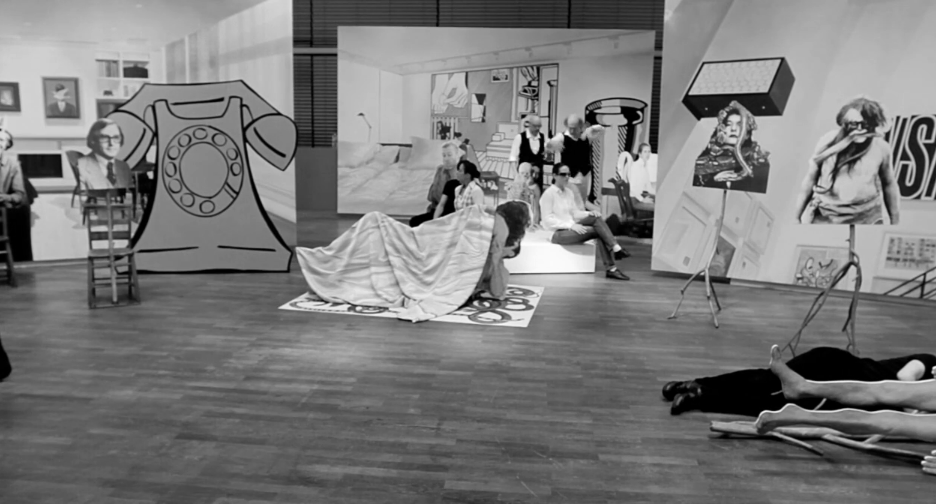
20 | The Andrea Fraser cutout, center stage, with the legs of the Dead Dad cutout on the right. From Scene Three in the performance-film of Preparatory Notes for a Chicago Comedy (2013-2014); footage from the Staatliche Museen zu Berlin performance, Berlin Biennale 2014.
We are going to talk about art, money and politics. And how they’re in bed with each other, all the time— both for better and for worse.
Actors 3 and 4, seated, roll the bed forward with their feet towards the stage
Let’s be clear about that.
One of the dancers lies behind dead dad, the other one moves to sit on the bed as do Actors 2, 3 and 4. Actor 1 is standing
Which is why we find ourselves in a bedroom, in bed.
Everyone on the bed is looking either at Warburg 1 speaking or the audience
The history of art, which coincides with the history of money, is full of beds, and not just for sleeping. This may be the source, possibly, of the expression “to be embedded”, which actually originated in the world of journalism, right? In the art world, where they also like to be embedded, it basically means to be in bed—with this, that or the other, depending on one’s taste. “Sleeping with the enemy” as they say—or with “friends with benefits.”
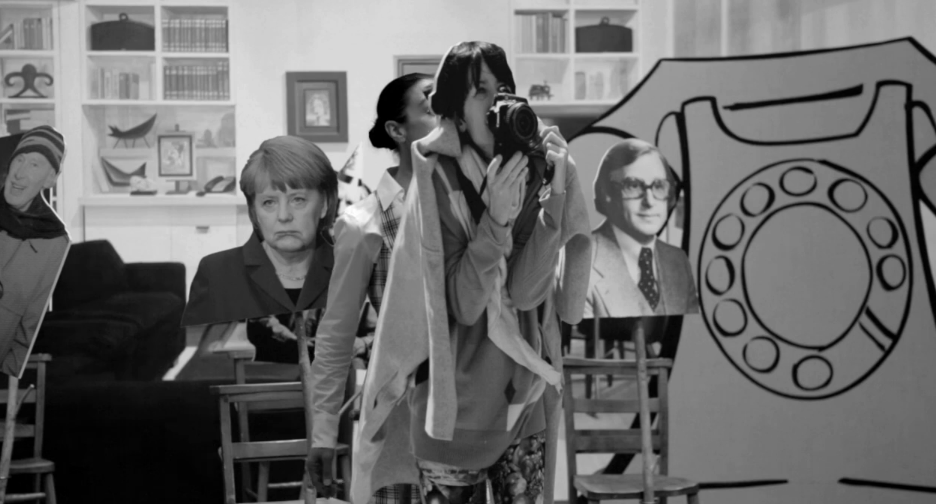
21 | “Hello, my name is Goshka Macuga. I am the artist and I like to be embedded”. From Scene Three in the performance-film of Preparatory Notes for a Chicago Comedy (2013-2014); footage from the Staatliche Museen zu Berlin performance, Berlin Biennale 2014.
Actor 1 sits down, Actor 3 walks to behind the Goshka Macuga cutout
Goshka Macuga
(Actor 3)
Hello, my name is Goshka Macuga. I am the artist and I like to be embedded.
Actor 2 walks to behind the Dieter Roelstraete cutout, arms outstretched and speaking theatrically
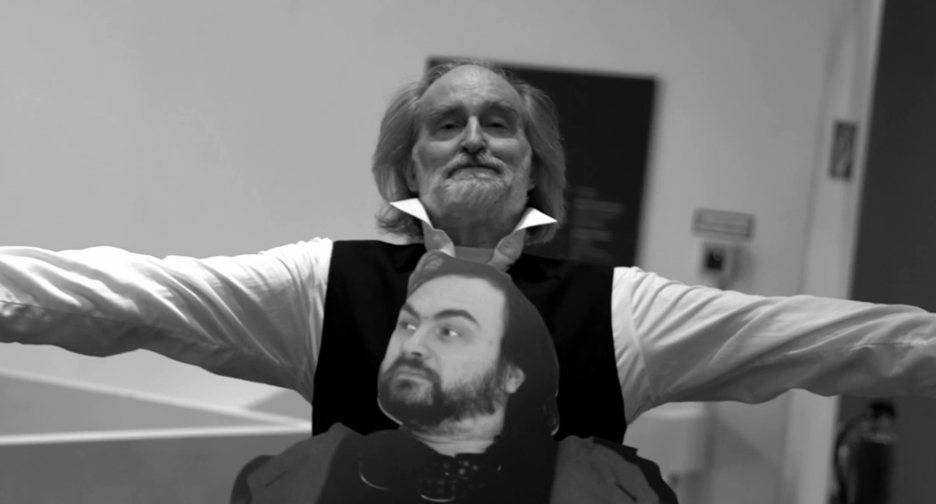
22 | “Hello, my name is Dieter Roelstraete. I am the curator and I also like to be in bed”. From Scene Three in the performance-film of Preparatory Notes for a Chicago Comedy (2013-2014); footage from the Staatliche Museen zu Berlin performance, Berlin Biennale 2014.
Dieter Roelstraete
(Actor 2)
Hello, my name is Dieter Roelstraete. I am the curator and I also like to be in bed.
Actor 1 stands up behind the Roman Abramovichh cutout which is on the bed. He is reading from a book
Roman Abramovich
(Actor 1)
Firstly he speaks briefly in Russian, then with a heavy Russian accent
My name is Roman; I’m the other Abramovićh. This one’s spelled with C H though. I love football. I have no Napoleonic dreams. I am just hardworking and pragmatic. And, yes, I happen to have many beds—in yachts, villas, townhouses, and in private jets as well. That’s all I’m going to say for now, because I’m not very good at speaking in public—or very much interested in it for that matter.
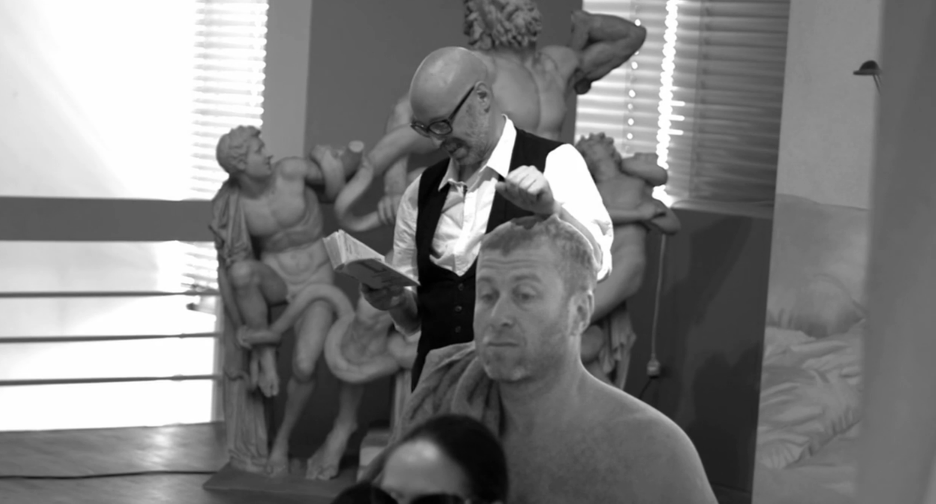
23 | “My name is Roman; I’m the other Abramović”. From Scene Three in the performance-film of Preparatory Notes for a Chicago Comedy (2013-2014); footage from the Staatliche Museen zu Berlin performance, Berlin Biennale 2014.
Dasha Zhukova
(Actor 4)
Actor 4, sitting on the bed in the same pose as the cutout, with an American accent
I am Dasha Zhukova and I share Roman’s many beds. You know me from that photograph,
She points to the photo of Dasha Zhukova
which was released on Martin Luther King Day—that’s January 20th,
She lifts up her glasses
for those of you who don’t know. I just wanted to say that said photograph, which has been published completely out of context, is of an artwork intended specifically as a commentary on gender and racial politics. I utterly abhor racism,
A gesture to the audience
and would like to apologize to anyone who has been offended by this image.
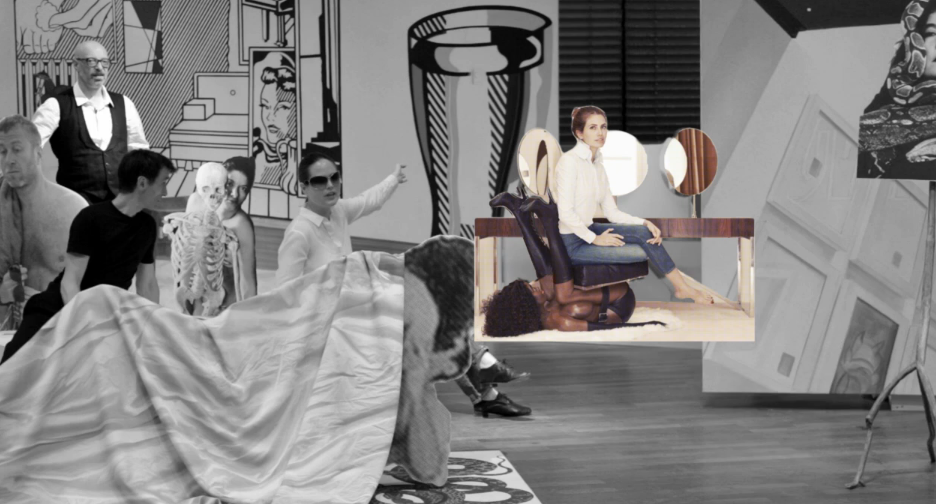
24 | “I am Dasha Zhukova (...) I utterly abhor racism and would like to apologize to anyone who has been offended by this image”. From Scene Three in the performance-film of Preparatory Notes for a Chicago Comedy (2013-2014); footage from the Staatliche Museen zu Berlin performance, Berlin Biennale 2014.
Dead Dad
(Dancer)
Dancer from behind the cutout
I am Dead Dad and I haven’t seen a bed in ages. I would like to hear Andrea Fraser speak on this issue. She has considerable experience, after all, with working in bed I believe.
Actor 4 goes down to lying behind the Andrea Fraser cutout
Andrea Fraser
(Actor 4)
Actor 4 in a nasal American accent
I assume you are referring to Untitled, my performance from 2003 in which I filmed myself sleeping with a collector, yes, dear Dad? Dear Dead Dad? For an undisclosed amount of money, that is… Well, my own experience of doing the piece was really very empowering and quite in line with my understanding of my own feminism. It was my idea; it was my scenario. I was producing a piece that I would own. I was very much in control of the process. I never felt used by the collector.
The dancers take off the cloth covering the Andrea Fraser cutout, lying under it —a lot of suggestive movements with hands and shoes poking out of the sheet. Actor 1, 2 and 3 are standing listening to Andrea Fraser
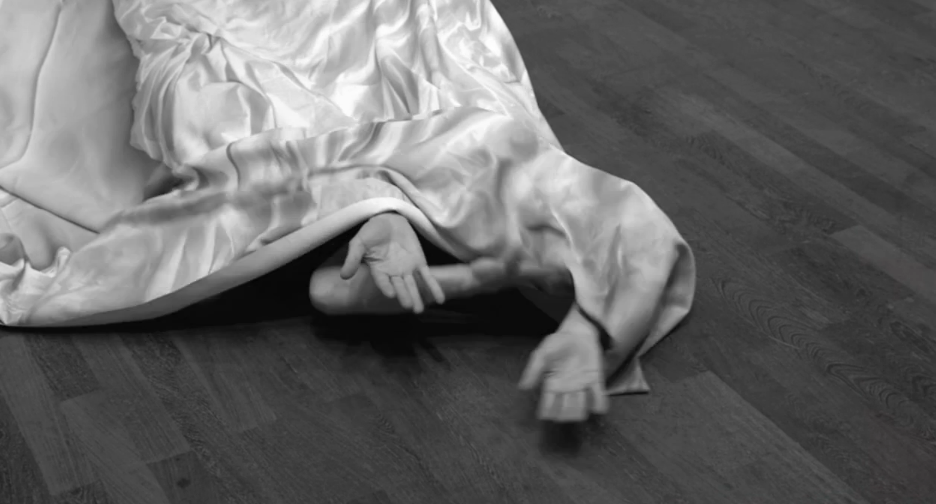
25 | The dancers take off the cloth covering the Andrea Fraser cutout, lying under it: gestures from Scene Three in the performance-film of Preparatory Notes for a Chicago Comedy (2013-2014); footage from the Staatliche Museen zu Berlin performance, Berlin Biennale 2014.
In fact, I was much more concerned about using him. And showing it has also been empowering—terrifying, but empowering. Almost everyone I know has now seen me have sex on camera. In a way, I am now impervious to physical exposure and voyeurism. So, that was my experience. But I know I can’t project that onto sex work generally, or prostitution. I think it’s sort of ridiculous to say that the piece was prostitution.
You know, people certainly can argue with this, but it really was a very different kind of relationship, one in which I had an enormous amount of power.
Actor 2 goes over and watches the dancers, he then moves over to the Dieter Roelstraete cutout
It is art, and the question I’m interested in posing is whether art is prostitution—in a metaphorical sense, of course. Is it any more prostitution because I happen to be having sex with a man than it would be if I were just selling him a piece? In fact, I remain much less comfortable with selling the DVDs of Untitled than I was with producing the piece. The “normal” sales situation that one has in the art world feels much more exploitative to me than any aspect of my relationship with, or the exchange with the participating collector. That’s where I lose control of it. That’s where the speculation begins. That’s where some hypocrites have called me a whore.
Aby Warburg
(Actor 1)
That’s the art world for you: someone pays you to sleep with him and you call it performance—nice. And that brings us back to the entanglement of art and money.
The dancers under the sheet continue to move suggestively and vigorously
Andrea, you—who else? —have written about this quite eloquently I believe.
Actor 3 moves to behind the cutout of Marina Abramović
In an essay titled “Le 1%, c’est moi,” right? Yes, the mythical 1%… What would we do without them?? Andrea, would you mind reading from the essay in question? But please, don’t let that distract you from what you’re doing—it seems you’re enjoying yourself somewhat.
Marina Abramović
(Actor 4)
Lucky her. In Balkans I usually only get to fiddle with snakes or skeletons.
Dead Dad
(Dancer)
Over my dead body, Marina!
Actor 3 moves to the Goshka Macuga cutout. The dancers stop dancing under the cloth, one moves to behind Dead Dad, the other to the bed
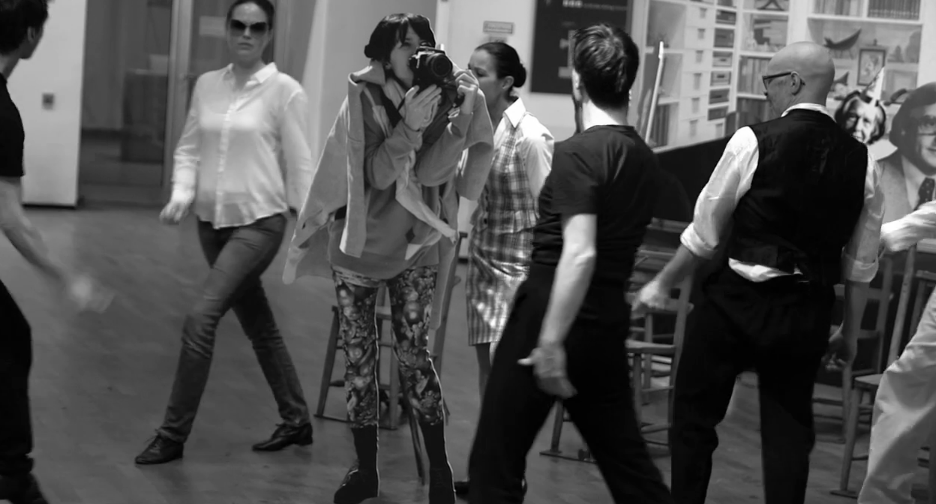
26 | Actor 3 [playing Ludovica Binswanger and Marina Abramovic] moves to the Goshka Macuga cutout. From Scene Three in the performance-film of Preparatory Notes for a Chicago Comedy (2013-2014); footage from the Staatliche Museen zu Berlin performance, Berlin Biennale 2014.
Andrea Fraser
(Actor 4)
Let me see where to start. Oh, here perhaps, where I am addressing the relation between the booming art market and growing income inequality and the concentration of wealth in ever fewer hands. Yes Roman, I am talking about you here—this is a particularly good quote: “except to stalwart adherents of trickle-down theory, it must be abundantly clear by now that what has been good for the art world has been disastrous for the rest of the world.” Touché! If you don’t mind me saying so.
Dieter Roelstraete
(Actor 2)
Gesturing with arms from behind the cutout
There you have it—the entire contemporary art world’s problem summed up in a single sentence. And the question is: how can we continue to justify our taking part in this deranged economy?
Dead Dad
(Dancer)
Over my dead body!
Aby Warburg
(Actor 1)
Well, let’s hear it from Miss Fraser. How can we continue to justify our taking part in such an economy?
Andrea Fraser
(Actor 4)
I believe I already answered your question. If our only choice is to participate in this economy or abandon the art field entirely, at least we can stop rationalising that participation in the name of critical or political art practices or—adding insult to injury—social justice. Indeed, the only “alternative” today is to recognise our participation in that economy and confront it in a direct and immediate way in all of our institutions, including museums, galleries, and publications.
Actor 1 has been walking around the bed
Roman Abramovich
(Actor 1)
Or in theatre plays. Let me pay for this one, OK? Waiter? Can I have the bill?
Goshka Macuga
(Actor 3)
Listen, this is all a little too depressing for our taste, frankly.
All the actors move towards the Goshka Macuga cutout snapping the fingers of their right hand synchronously. They form a circle and continue to click their fingers moving their hips back and forward, dancing with Goshka Macuga
Give peace a chance! First of all, we think Andrea is primarily speaking from an American perspective here—one that may end up romanticising the so-called alternatives somewhat. This is just too one-dimensionally bleak a picture. I mean, why did we become artists or curators in the first place? And why did anyone ever start collecting art? Surely not for the love of money. Sometimes art and money don’t have anything to do with each other. You can choose to be outside of it all—you can choose to be outsiders.
All the actors apart from Actor 3 continue dancing while moving across to the right of the stage
Dead Dad
(Dancer)
What, like outsider artists? That’s not very embedded.
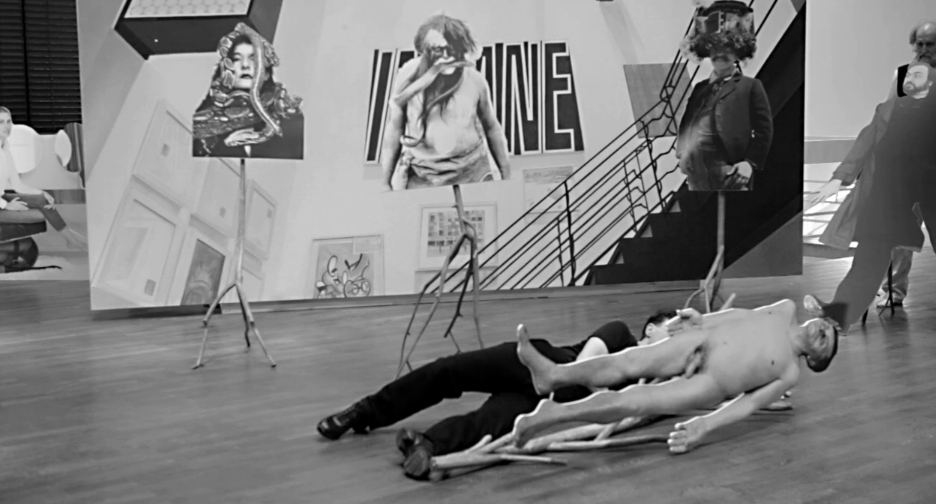
Fig. 27 One of the dancing twins playing the Dead Dad cutout in Scene Three from the performance-film of Preparatory Notes for a Chicago Comedy (2013-2014); footage from the Staatliche Museen zu Berlin performance, Berlin Biennale 2014.
Dasha Zhukova
(Actor 4)
“Let’s Go Outside.” I love that song.
Everyone, apart from Goshka Macuga, starts to dance with the cutouts freestyle
Roman Abramovich
(Actor 1)
Let me buy it for you. Waiter?
Everyone, apart from Goshka Macuga, continues dancing while moving to the back of the stage
Goshka Macuga
(Actor 3)
Roman, you and others of your kind make more money than you can spend so in order not to look vulgar you choose to affiliate yourself with culture. You are not the only one to do so. Many give a few thousand here and there, to this museum or that art project, and instantly become part of the elite of rich, powerful and sophisticated art lovers.
Everyone, apart from Goshka Macuga, is now dancing wildly across the back stage
Goshka Macuga
(Actor 3)
In the art world no one will ask you where your money came from, whether it is dirty or clean. This is where the circle closes. That’s when, and why, they, the moneymakers, want to be in bed with us, the artists.
Everyone, apart from Goshka Macuga, moves to dance around and on the bed. Goshka Macuga moves to the bed and raises her fist in the air.
Goshka Macuga
(Actor 3)
The cast join in with hands in the air
I want to break free from this circle and become a square!
Dasha Zhukova
(Actor 4)
“I want to break free”! I love that song…
Aby Warburg 1
(Actor 1)
Everybody, don’t beat yourself up too much over the question of money. I know your pain—I, too, had to break free and give away mine. It was driving me crazy.
All the actors sit around Warburg 1 at the front of the bed
And so I gave my life to art instead. That’s the dream I dreamt, the one madness I believed in.
Starts screaming, lying on the bed
In the moment of my death I regained my voice.
Warburg 2 stand up walks towards the front of the stage and falls down, curling into a fetus position away from the audience
(Actor 1 playing Warburg 2)
Mary! Mary! Marry me, Holy Mary!
A dancer moves to behind Dead Dad. The actors on the bed are looking at the audience
Dead Dad
(Dancer)
(in the words of Cormac McCarthy): One could say that we are all still living in Warburg’s world—the world of his own mad making. There is no denying the reality of the world we are in, mad or not. We are the world we have created, and when we cease to exist this world we have created will also cease to exist.
The actor playing Goshka Macuga moves from the bed to behind the cutout
Goshka Macuga
(Actor 3)
But death is not the end. What we create will live on—if it’s well enough made.
Aby Warburg
(Actor 1)
Yes. Yes indeed, it is these artworks, these documents of collective memory, that allow us to understand the psyche of both those who created them—I’m looking at you here, Goshka—and those who commissioned them—Roman?
The dancers get up and lift the Andrea Fraser cloth into a curtain at the front of the stage.
The actors get up one at a time and move into a line behind the curtain
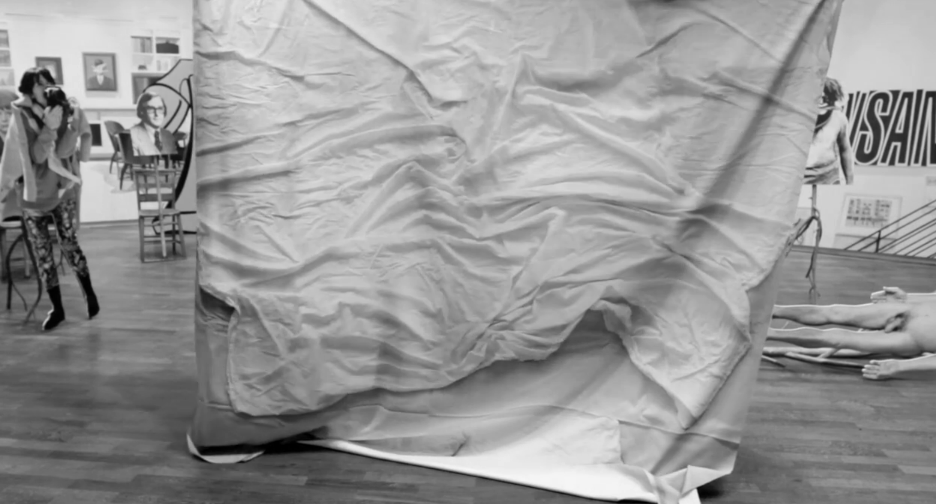
Fig. 28 |The dancers (...) lift the Andrea Fraser cloth into a curtain at the front of the stage. The actors (…) move into a line behind the curtain. From Scene Three in the performance-film of Preparatory Notes for a Chicago Comedy (2013-2014); footage from the Staatliche Museen zu Berlin performance, Berlin Biennale 2014.
Roman Abramovich
(Actor 1)
Popping out from behind the curtain
Hello, waiter? How much? What? Can I have a discount? Like, 75%?,50%?,25%?
Notes
*This script is the original script from the stage performance and does not include the character of the voice-over/voice-off narrator. The latter character was added in the performance-film version of the Comedy.
[1] Yugoslav, American b., 1946, performance artist
[2] Russian b. 1966, businessman, investor, politician and art collector
[3] American 1923 - 2013, painter and sculptor
[4] Swiss 1881 - 1966, psychiatrist and existential psychologist
[5] American 1912 - 1992, composer and theorist
[6] French, American, 1887 - 1968, artist and chess-player
[7] American, b. 1965, performance artist
[8] Polish, British b. 1967, sculptor and scenographer
[9] German, b. 1954, German chancellor and former chemist
[10] Belgian, b. 1972, writer and curator
[11] Dutch, American 1942 - 2010, museum administrator
[12] German 1866 - 1929, scholar and amateur playwright
[13] Russian b., socialite and art collector
[14] A photograph from the Library of Congress, Washingon D.C. (Hopi Indian Study #28, 1924. Photographer unknown) which has come to be associated with Warburg through Philippe-Alain Michaud’s Aby Warburg and the Image in Motion. 2004. p. 224.
[15] A mixed-media sculpture by British artist Ron Mueck famed for having been shown at the exhibition Sensation at the Royal Academy in 1997. Sensation, a show of work collected by advertising mogul Charles Saatchi, promoted a group that had come to be known as the Young British Artists (YBAs).
English abstract
The contribution reports the original script from the stage performance of Goshka Macuga’s Preparatory Notes for a Chicago Comedy, a piece she conceived as an Artist in Residence at the MCA Chicago in 2013. Macuga’s play features various past and contemporary figures of the art world, and among them Aby Warburg. The work is in fact inspired by Warburg’s 1896 play Hamburg Conversations on Art: Hamburg Comedy.
keywords | Macuga; A Chicago Comedy; Warburg; “Hamburg Comedy”; “Hamburg Conversations on Art and Culture”.
To cite this article: G. Macuga, in collaboration with D. Roelstraete, Preparatory Notes for Chicago Comedy (2013), “La Rivista di Engramma” n. 130, ottobre/novembre 2015, pp. 97-167 | PDF